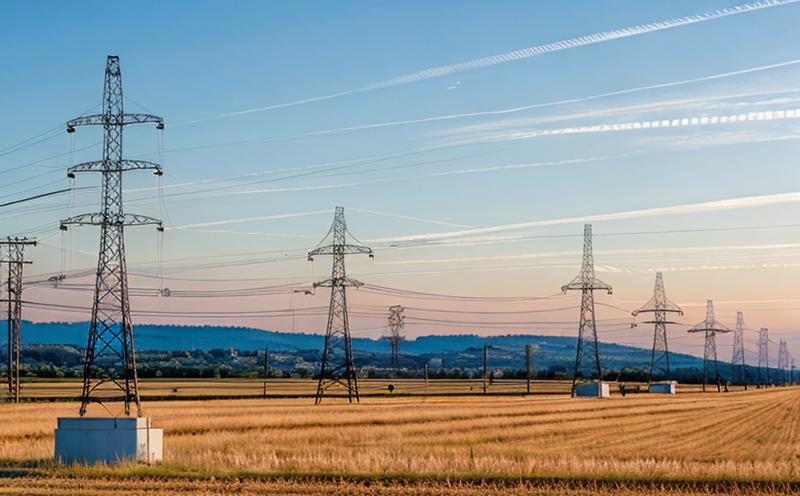IEC 62497-1 Insulation Coordination Testing in Distribution Systems
The IEC 62497-1 standard is a critical guideline for the design, testing, and implementation of insulation coordination within distribution systems. This standard ensures that electrical equipment operates safely under various fault conditions without experiencing insulation breakdown or failure. It covers the selection, calculation, and application of protective devices to safeguard both personnel and equipment.
Insulation coordination is a complex process involving multiple factors including voltage levels, current magnitudes, and environmental stressors. The standard provides detailed methodologies for assessing and managing potential risks associated with insulation breakdown in power distribution networks. This testing is essential for ensuring that electrical systems are robust enough to withstand overvoltage conditions without compromising safety or reliability.
One of the key aspects of IEC 62497-1 involves evaluating the performance of protective devices such as circuit breakers, fuses, and surge protectors. These components play a crucial role in preventing damage to distribution systems during faults while minimizing downtime and ensuring continuity of supply. Proper coordination between these devices ensures that only the smallest possible area is affected by any fault event.
The testing process outlined in IEC 62497-1 involves several stages, each designed to assess different facets of insulation performance under various conditions. Initially, specimens are prepared according to specified criteria ensuring they accurately represent real-world scenarios. Once prepared, the specimens undergo rigorous testing using specialized equipment capable of simulating fault currents and voltages.
Testing procedures typically involve applying test pulses that simulate actual fault conditions, measuring resulting insulation resistance values, and analyzing data collected from these tests. Results are then compared against predefined acceptance criteria outlined in IEC 62497-1 to determine compliance with the standard. Compliance ensures not only safety but also optimal performance of distribution systems.
Another important aspect of this testing involves evaluating protective device coordination within the system. This requires careful calculation and simulation to ensure that when a fault occurs, the correct protective devices operate in sequence rather than simultaneously causing unnecessary outages or potential damage. Proper coordination can significantly enhance reliability and reduce maintenance costs associated with electrical systems.
The impact of IEC 62497-1 extends beyond mere compliance; it contributes to broader objectives related to sustainability, safety, and efficiency in power distribution networks. By ensuring that insulation materials and protective devices perform optimally under all expected operating conditions, this standard promotes the development of more resilient and efficient electrical systems.
- Reduces risk of insulation breakdown leading to costly repairs or outages
- Promotes use of sustainable materials in insulation design
- Increases reliability by ensuring proper coordination between protective devices
- Enhances safety for personnel working on distribution systems
Benefits
The benefits of adhering to IEC 62497-1 are manifold, encompassing not only immediate improvements in system performance but also long-term cost savings and enhanced safety measures. By ensuring that insulation coordination is properly implemented according to this standard, utilities can significantly reduce the likelihood of equipment failures due to insulation breakdown.
Properly coordinated protective devices contribute directly to increased reliability by minimizing unnecessary outages caused by faults. This not only enhances customer satisfaction but also reduces operational costs associated with unplanned downtime. Additionally, compliance with IEC 62497-1 helps utilities meet regulatory requirements and gain credibility among stakeholders.
From an environmental perspective, the standard promotes the use of sustainable materials in insulation design, which can lead to reduced energy consumption during production processes. Furthermore, by promoting the development of more efficient and resilient electrical systems, IEC 62497-1 supports broader efforts towards achieving sustainability goals within the power sector.
For R&D engineers, the standard provides a robust framework for innovation in insulation coordination techniques. By setting clear guidelines on testing procedures and acceptance criteria, it encourages continuous improvement in design methodologies aimed at enhancing overall performance metrics such as durability, flexibility, and cost-effectiveness.
International Acceptance and Recognition
The IEC 62497-1 standard has gained widespread acceptance across the global power sector due to its rigorous approach to insulation coordination testing. Countries around the world recognize this standard as a best practice for ensuring safe and reliable operation of distribution systems.
Many regulatory bodies incorporate references to IEC 62497-1 in their own guidelines, further cementing its position as an industry benchmark. This recognition translates into increased confidence among stakeholders regarding the quality assurance processes employed by compliant entities.
The standard's international acceptance also facilitates smoother trade between countries by harmonizing technical specifications related to insulation coordination practices. As more nations adopt these standards, it becomes easier for utilities operating internationally to comply with local regulations without significant modifications to existing procedures.





